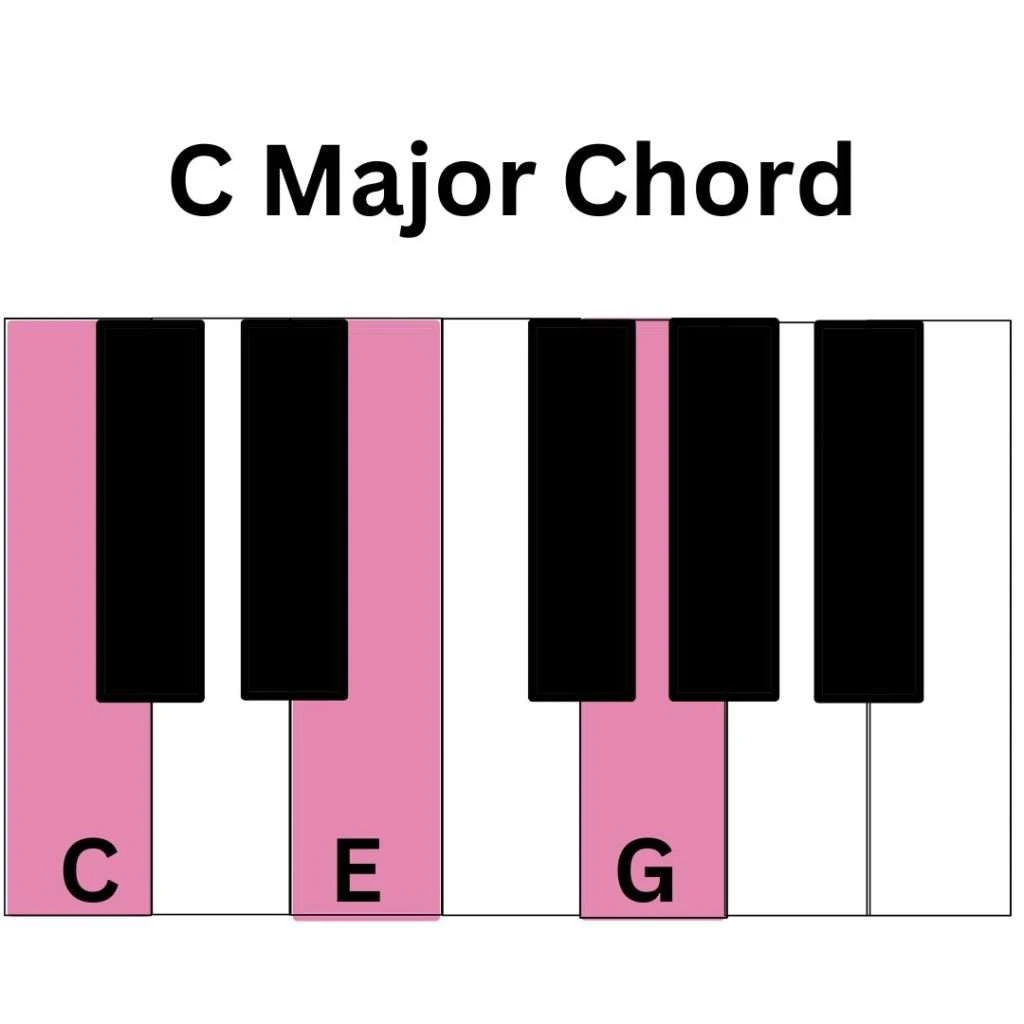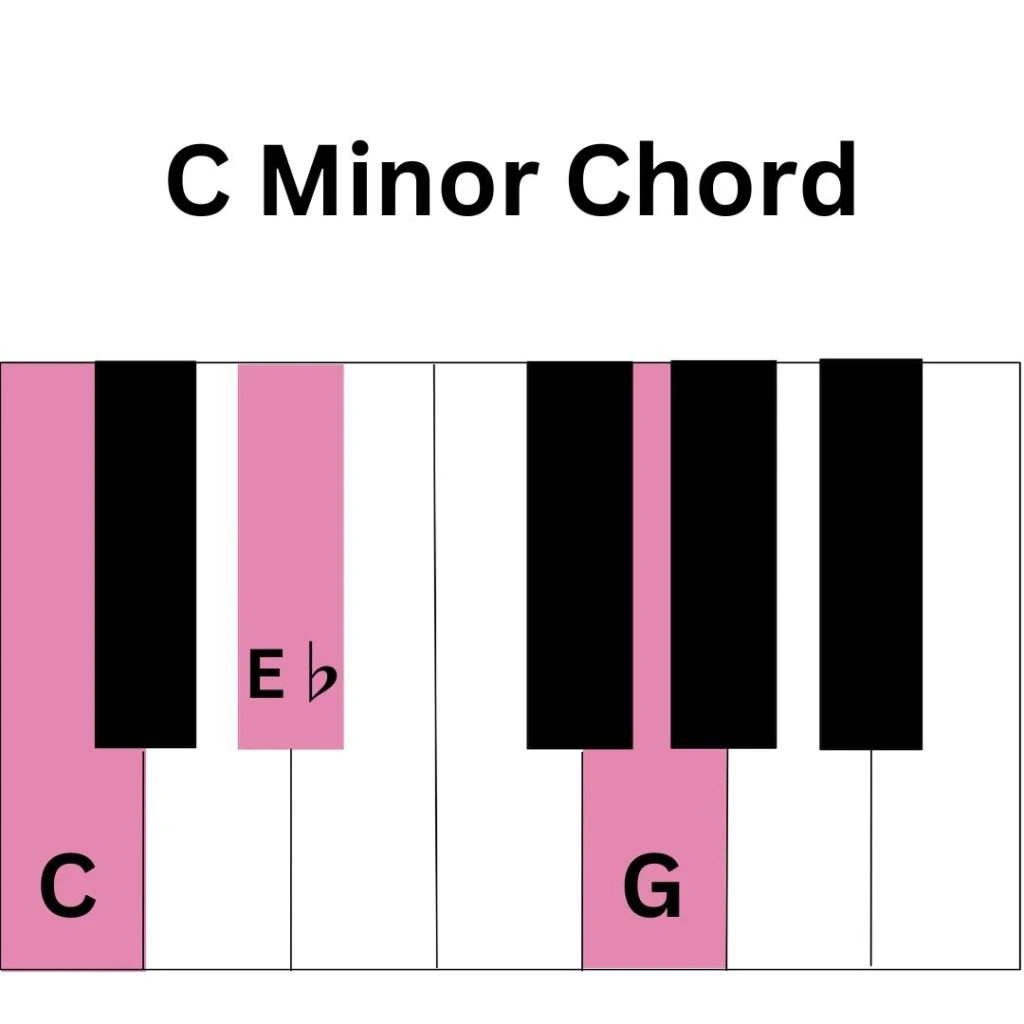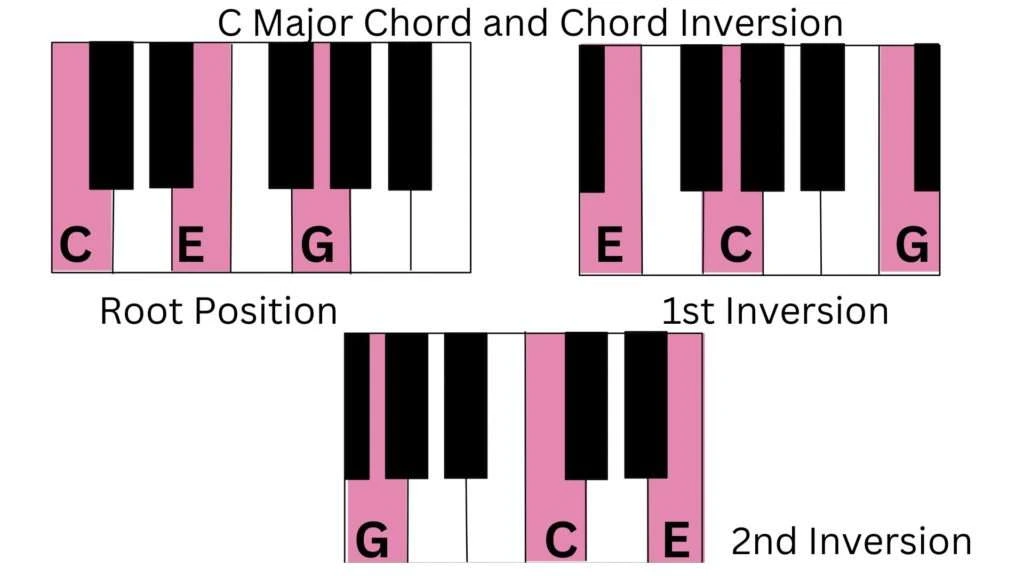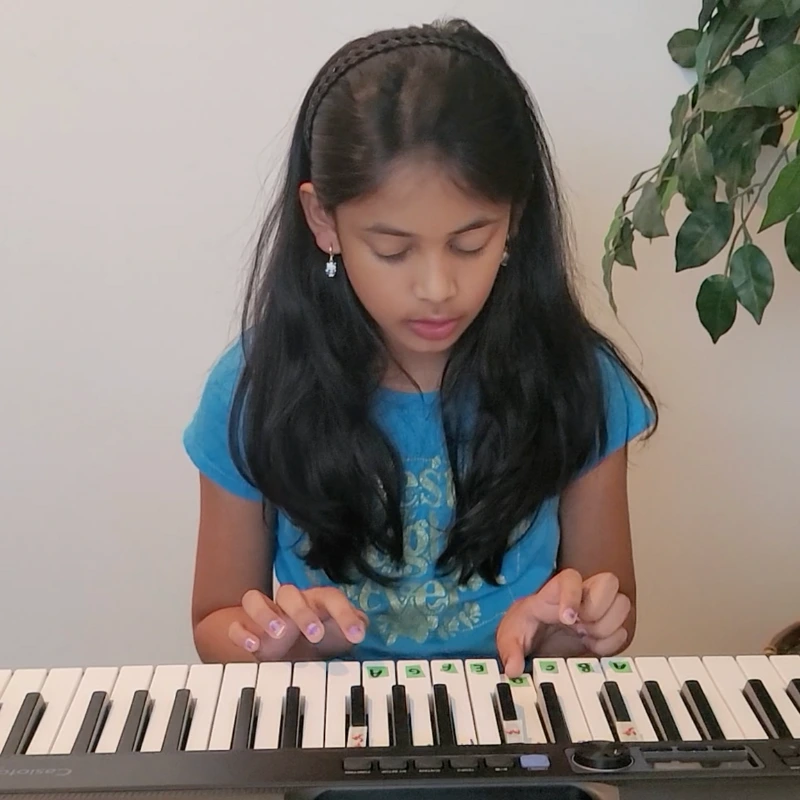The knowledge of chords is integral for music composition. Learning about the chords is extremely important for musicians and composers because the knowledge of chords is integral for music composition and subsequently playing them on instruments, for instance, piano chords or guitar chords
What is a chord?
When three or more chords are played together, it is called a Chord. The pitches present in a chord vary. A chord contains three or four pitches but it in some cases, can also go up to five or six pitches.
What is the Meaning of a Piano Chord?
Chords are a creation of 3 or more notes. When the same concept is applied to a piano it is known as a piano chord. In other words, a piano chord is when there are three or more keys on a piano. These piano chords can be major or minor. One can also build chords with the help of the circle of fifths.
You should check about “Introduction to the Circle of Fifths” article, to know more about you can form a Major or a Minor piano chord with Circle Of Fifths.
What is a Root Note?
Now that you know what is needed to form a chord, ie., are three or more notes. Among those notes, one of the notes especially stands out which is the “Root Note.” The root note is like the foundation on which a chord is built. You can say that a Root Note is a starting point of forming a chord. This is also known as the starting note.
For instance, C-E-G are the notes of a C Major Chord wherein C is its Root Note.
What is chord quality?
In simple words, Chord Quality is basically how a Chord Sounds when it is played. That actually depends on the Intervals used during the formation of a particular chord. Major, Minor, Diminished, Augmented are some of the names of the Chord Qualities.
Types of chords.
Triads
The three notes in a chord are called a Triad. They are the chords that are mainly used when playing piano. Triads can further be divided into different types.
Major Triad
A major triad consists of a Root Note, a Major Third, and a Perfect Fifth. The perfect fifth is when the minor third and major third are added above the root note. For example, let’s take the C major:
- C here is the root note and that’s how the chord has got its name.
- The next note of a Chord is three tones higher to C which is the Major Third- E. You can count it.
- If you count 7 semitones from C, the Perfect Fifth- G is set. G is also 3 semitones from E.
Now, C Major Chord- C E G is formed.

The table below contains more major chords commonly played on a piano.
| Major Chord | Chords Played |
| C major (C) | C – E – G |
| D major (D) | D – F# – A |
| E major (E) | E – G# – B |
| F major (F) | F – A – C |
| G major (G) | G – B – D |
| A major (A) | A – C# – E |
| B major (B) | B – D# – F# |
| C# major (C#) | C# – E# – G# |
| Eb major (Eb) | Eb – G – Bb |
| F# major (F#) | F# – A# – C# |
| Ab major (Ab) | Ab – C – Eb |
| Bb major (Bb) | Bb – D – F |
The sound produced by the major scales is described as positive, uplifting, and happy.
Minor Triad
A Minor triad just like a Major Triad has a Root Note, a Minor Third, and a Perfect Fifth. Minor scales are similar to major scales but in the case of minor triads, we interchange the position of the minor thirds and the major thirds.
Let’s take another example of the C note:
- C is the Root Note of the chord.
- Three semitones higher from C is the Minor Third “E♭.”
- And 7 semitones higher from the root note C, is the Perfect Fifth G
And so, C minor chord is consists these three notes C – E♭ – G.

MUSICMASTER also has a very useful article “How to play Piano”. Check that out to lean more.
The table below contains more minor chords commonly played on a piano.
| Major Chord | Chords Played |
| C minor | C – Eb – G |
| D minor | D – F -A |
| E minor | E – G – B |
| F minor | F – Ab – C |
| G minor | G – Bb – D |
| A minor | A – C – E |
| B minor | B – D – F# |
| C# minor | C# – E – G# |
| Eb minor | Eb – Gb – Bb |
| F# minor | F# – A – C# |
| Ab minor | Ab – Cb – Eb |
| Bb minor | Bb – Db – F |
The sound produced by the minor scales is described as melancholy, sad, and dark.
Diminished triad
Root Note, Minor Third and a Flat Fifth are the three notes that can be found in a Diminished Triad or a Diminished Chord. Diminished chords aren’t as widely used as their major or minor counterparts but nonetheless serve an important purpose. Once again let’s better understand the chords through an example.
- C is the root note thus the name of the chord.
- Count up to 3 semitones from C and you will get the minor third “E♭.”
- Count up to 6 semitones from C or 3 semitones from E♭ to get the flat fifth G ♭/ F♯
Thus, the C diminished chord is composed of the 3 notes C – E♭ – G ♭/ F♯.
The table below contains more diminished chords commonly played on a piano.
| Major Chord | Chords Played |
| C diminished | C – Eb – Gb |
| D diminished | D – F – Ab |
| E diminished | E – G – Bb |
| F diminished | F – Ab – Cb |
| G diminished | G – Bb – Db |
| A diminished | A – C – Eb |
| B diminished | B – D – F |
| C# diminished | C# – E – G |
| D# diminished | D# – F# – A |
| F# diminished | F# – A – C |
| G# diminished | G# – B – D |
| A# diminished | A# – C# – E |
Diminished chords are also the Minor Chords with Flat Fifths. For an example, C- Eb- G is the C Minor Chord. If Fifth note pulled down a semitone, we have C- Eb- Gb, a C dim chord.
The sound produced by the diminished chords is described as unpleasant and tense.

Did You Know?
All the Major or Minor Key in Music will have 3 Major and Minor Chords and 1 Diminished chord.
Augmented Triads.
An Augmented triad has a root note, a major third, and an augmented fifth. Augmented fifth is when a perfect is raised by one semitone. Let’s take the example of an augmented C chord.
- C is the root note here.
- Four semitones from C will get us the major third “E.”
- Eight semitones or four tones from C gets us the Augmented Fifth – G♯.
And that’s how C augmented chord is formed with the 3 notes C – E – G ♯.
The table below contains more major chords commonly played on a piano.
| Major Chord | Chords Played |
| C augmented | C – E – G# |
| D augmented | D – F# – A# |
| E augmented | E – G# – B# |
| F augmented | F – A – C# |
| G augmented | G – B – D# |
| An augmented | A – C# – E# |
| B augmented | B – D# – F## |
| C# augmented | C# – E# – G## |
| D# augmented | D# – F## – A## |
| F# augmented | F# – A# – C## |
| G# augmented | G# – B# – D## |
| A# augmented | A# – C## – E## |
Augmented chords creates suspenseful or anxious sounds.
SUSPENDED TRIADS.
The suspended triad or the suspended chord is a triad that includes the root note, major note(except the major third), and the perfect fifth. A suspended chord has a similar structure as a major chord except using the major third and replacing it with other majors such as major second or major fourth. Sus is the abbreviation used for the word suspended in music.
Sus2 Chords.
Like any other chord, the Sus2 chord consists of a Root Note, a Major Second, and a Perfect Fifth.
While creating the C Sus2 chord one must use the following notes.
- C is the root note thus the name of the chord.
- Count up to 2 semitones from C and you will get the major second “D.”
- Seven semitones from C the perfect fifth G.
Thus, the C Sus2 chord is composed of the 3 notes C – D – G.
Sus4 Chords
The Sus4 chord is like the Sus2 chord except it has Major fourth instead of major second. Sus4 consists of the root note, the major fourth, and the perfect fifth.
- C is the root note thus the name of the chord.
- Five semitones from C and you will get the major fourth or the perfect fourth “F”
- Seven semitones from C take us to the perfect fifth – G
Thus, the C Sus2 chord is composed of the 3 notes C – F – G.
The sound produced by the suspended chords is described as nervous and bright.
7th Chords
For the creation of the 7th chord add an extra note to a triad and the interval of the 7th above the root note or in simpler words the 7th chord consists of four notes the Root, the Third, the Fifth, and the Seventh. There are few Types of 7th chords,
Major 7th Chord.
You can find a Root Note, a Major Third Note, a Perfect fifth, and a Major Seventh in a Major 7th Chord. This chord is formed just by adding a major seventh to a major triad note. For example, let’s look at the composition of the C major 7th chord.
- C is the root note thus the name of the chord.
- Count up to 4 semitones from C and you will get the major third “E.”
- Count up to 7 semitones from C or 3 semitones from E to get the perfect fifth or the minor third G.
- Count up to 11 semitones from C, 7 semitones from E, or 4 semitones from G to get the major seventh B
And so C major 7th chord is has these 4 notes C – E – G – B
You can find major 7th chords in the Jazz Genre. 7th chords are the specialty of Jazz. As the sound produced by the major 7th chord is described as soft, thoughtful, and relaxing. The major 7th chord is definitely softer in comparison to the dominant 7th.
Minor 7th Chord.
The Minor 7th chord Notes are as follows: Root Note, Minor Third, Perfect Fifth, and a Minor Seventh Note. Let’s look at the formation of the C minor 7th chord.
- C is the root note thus the name of the chord.
- Count up to 3 semitones from C and you will get the minor third “E♭.”
- 4 semitones Higher from E♭ gets us the perfect fifth – G
- Finally, 3 semitones from G gets us the minor seventh B♭
Thus, the C minor 7th chord is composed of the 4 notes C – E♭ – G – B♭.
The minor 7th chord also has a jazzy feel to it but the sound produced by the minor 7th chord is described as thoughtful, musing, and moody.

Did You Know?
Chords can be played simultaneously(Triads) and in the form of Arpeggios (Broken Chords)
Dominant 7th Chord
The Dominant 7th chord would have a Root note, a Major Third note , a Perfect Fifth note, and a Minor Seventh note in it. A Dominant 7th chord can also be seen as adding a minor seventh to a major triad. You need to follow these steps to form a dominant chord of the key C.
- C is the root note thus the name of the chord.
- Count up to 4 semitones from C and you will get the major third “E.”
- Count up to 7 semitones from C or 3 semitones from E to get the perfect fifth or the minor third G.
- Finally, count up to 10 semitones from C, 6 semitones from E, or 3 semitones from G to get the minor seventh B♭
So a C dominant 7th chord has C – E – G – B♭.
The dominant 7th is widely used in the blues and jazz genres. Its use can also be seen in R&B, hip-hop, and Edm. The sound produced by the dominant 7th is described as vibrant and strong.
Diminished 7th Chord.
A diminished 7th chord consists of a root note, a minor third, a flat fifth (diminished), and a diminished seventh. A diminished 7th chord can also be seen as adding a diminished seventh to a diminished triad. For example, let’s look at the composition of the C diminished 7th chord.
- C is the root note thus the name of the chord.
- Count up to 3 semitones from C and you will get the minor third “E♭.”
- Count up to 6 semitones from C or 3 semitones from E♭ to get the flat fifth G ♭/ F♯
- Finally, count up to 9 semitones from C, 6 semitones from E♭ , or 3 semitones from G♭ to get the diminished seventh B♭♭
Thus, the C diminished 7th chord is composed of the 4 notes C – E♭ – G♭/ F♯ – B♭♭.
The sound produced by the diminished 7th chords is described as scary, chilling, and tense.
Additional Chords.
In music, some chords have notes added beyond the triad or even seventh notes. The addition of a note results in the extension of the chord thus the name. The extended chords pass the seventh and go up to the next octave. They can also be an addition to already existing chords with 4 notes. Here are a few examples of these extended chords.
Major 9th chord.
The major 9th chord consists of a root note, a major third, a perfect fifth, a major seventh, and a major 9th. A major 9th chord can also be seen as adding a major ninth to a major seventh or an extension of a major 7th chord. Let us look at the formation of the C major 9th chord.
- C is the root note thus the name of the chord.
- Count up to 4 semitones from C and you will get the major third “E.”
- Count up to 7 semitones from C or 3 semitones from E to get the perfect fifth or the minor third G.
- Count up to 11 semitones from C, 7 semitones from E, and 4 semitones from G to get the major 7th B
- Count up to 14 semitones from C, 10 semitones from E, 7 semitones from G, or 3 semitones from B to get the major 9th D
Thus, the C major 9th chord is composed of the 5 notes C – E – G – B – D.
Minor 9th chord.
The minor 9th chord consists of a root note, a minor third, a perfect fifth, a minor seventh, and a major 9th. A minor 9th chord can also be seen as adding a major ninth to a minor seventh or an extension of a minor 7th chord. Here is how this chord is formed.
- C is the root note thus the name of the chord.
- Count up to 3 semitones from C and you will get the minor third “E♭.”
- Count up to 7 semitones from C or 4 semitones from E♭ to get the perfect fifth or the third major G
- Then count up to 10 semitones from C, 7 semitones from E♭, or 3 semitones from G to get the minor seventh B♭.
- Finally, count up to 14 semitones from C, 11 semitones from E♭, 7 semitones from G, or 4 semitones from B♭ to get a major 9th D
Thus, the C minor 9th chord is composed of the 5 notes C – E♭ – G – B♭ – D.
A Dominant 9th Chord
We would get a Dominant 9th chord just by adding a Major 9th note to the Dominant 7th chord. So this way you can find a Root Note, a Major Third, a Perfect Fifth, a Minor Seventh, and a Major Ninth notes. Let us form a C Dominant 9th chord,
- C is the root note thus the name of the chord.
- Count up to 4 semitones from C and you will get the major third “E.”
- Count up to 7 semitones from C or 3 semitones from E to get the perfect fifth or the minor third G.
- Finally, count up to 10 semitones from C, 6 semitones from E, or 3 semitones from G to get the minor seventh B♭
- Finally, count up to 14 semitones from C, 10 semitones from E, 7 semitones from G, or semitones from B♭ to get the major ninth D
Thus, the C dominant 9th chord is composed of the 5 notes C – E – G – B♭ – D.
Major 11th chord
The major 11th chord consists of a root note, a major third, a perfect fifth, a major seventh, a major ninth, and an eleventh. A major 11th chord can also be seen as adding an eleventh to a major ninth or an extension of a major 9th chord. For example, let’s look at the composition of the C major 11th chord.
- C is the root note thus the name of the chord.
- Count up to 4 semitones from C and you will get the major third “E.”
- Count up to 7 semitones from C or 3 semitones from E to get the perfect fifth or the minor third G.
- Count up to 11 semitones from C, 7 semitones from E, and 4 semitones from G to get the major 7th B
- Count up to 14 semitones from C, 10 semitones from E, 7 semitones from G, or 3 semitones from B to get the major 9th D
- Count up to 17 semitones from C, 13 semitones from E, 10 semitones from G, 6 semitones from B, or 3 semitones from D to get the eleventh F
The Keys in C major 11th chord are C – E – G – B – D – F.
Minor 11th Chord.
The minor 11th chord consists of a root note, a minor third, a perfect fifth, a minor seventh, a major ninth, and an eleventh. A minor 11th chord can also be seen as adding an eleventh to a minor ninth or an extension of a minor 11th chord. For example, let’s look at the composition of the C minor 11th chord.
- C is the root note thus the name of the chord.
- Count up to 3 semitones from C and you will get the minor third “E♭.”
- Count up to 7 semitones from C or 4 semitones from E♭ to get the perfect fifth or the third major G
- Count up to 10 semitones from C to get the minor seventh B♭.
- Then count up to 7 semitones from G, or 4 semitones from B♭ to get a major 9th D
- Lastly, 3 semitones from the note D will take you to the 11th note which is F.
Thus, the C minor 11th chord is composed of the 6 notes C – E♭ – G – B♭ – D – F.
Presenting Chords Through Roman Numerals.
In music, we use Roman numerals when representing chords. Roman numerals are used for indicating the degree of this scale or the scale step of the root node of the cord. The court quality is also indicated by the format of the Roman numerals.
The modern Roman numerals have different rules according to the type of triads For augmented triads/ augmented keys, they use uppercase for the numerals and also add a small + next to it. Lastly, for the diminished triads/ diminished keys, we use lowercase for the numerals and add a small circle next to them.
Major Keys in Roman Numerals
In major keys, we write the Ⅰ, Ⅳ, and Ⅴ keys in uppercase. Next, we use the lowercase to right ⅱ, ⅲ, and ⅵ keys. Lastly, to write the ⅶº key we use the lowercase and add a small circle next to it.
| Roman Numerals | Degree of Scale |
| Ⅰ | 1st degree |
| ⅱ | 2nd degree |
| ⅲ | 3rd degree |
| Ⅳ | 4th degree |
| Ⅴ | 5th degree |
| ⅵ | 6th degree |
| ⅶº | 7th degree |
In major triads, the numeral represents the following degree of the scales.
Let’s take the example of G major for better understanding:
| Roman Numerals | G major |
| Ⅰ | G |
| ⅱ | A |
| ⅲ | B |
| Ⅳ | C |
| Ⅴ | D |
| ⅵ | E |
| ⅶº | F# |
Minor keys in Roman Numerals.
In major keys, we write the ⅰ, ⅳ, and ⅴ keys in lowercase. Next, we use the uppercase to write Ⅲ, Ⅵ, and Ⅶ keys before them. Lastly, to write the ⅱº key we use lowercase and add a small circle next to it.
As we mentioned above the numerals represent the degree of the scale.
| Roman Numerals | Degree of Scale |
| ⅰ | 1st degree |
| ⅱº | 2nd degree |
| ♭Ⅲ | 3rd degree the or flat third degree |
| ⅳ | 4th degree |
| ⅴ | 5th degree |
| ♭Ⅵ | 6thdegree or flat 6th degree |
| ♭Ⅶ | 7thdegree or flat 7th degree |
In major triads, the numeral represents the following degree of the scales.
Let’s take the example of A minor for better understanding:
| Roman Numerals | Degree of Scale |
| ⅰ | A |
| ⅱº | B |
| Ⅲ | C |
| ⅳ | D |
| ⅴ | E |
| Ⅵ | F |
| Ⅶ | G |
Chord Inversion
In a chord we now know that there is a Root Note, third and fifth in that order. When we change the order or the position of those 3 notes, it is called a Chord Inversion. Chord inversions lets us be play the keys closer to each other on a piano. Any Chord can have two inversions.
Let’s break it down a bit more for better clarity.
We know the arrangement(as mentioned above) of a major chord/ major triad. For example, the C major triad consists of the root note C, the third note E, and the fifth note G. the arrangement of the C major triad looks like C – E – G.
First Inversion of a C major chord is when we change the position of the Third note E and place it below the root note. In that way E – C – G is the First Inversion of a C major chord
Second Inversion of a C major chord is when we change the position of the fifth note G and place it below the root note. In that way G – C – E is the Second Inversion of a C major chord
The image below is an example of a C major triad/chord and the inversions on a piano.

Conclusion
Chords are one of the best ways for expressing emotions through music as we learned in this blog how the combination of different notes creates different chords which result in the production of a variety of sounds. We introduced you to a few of them but there are many more such chords. Lastly, keep learning and enjoying music.





























